By Jeremy Burchardt
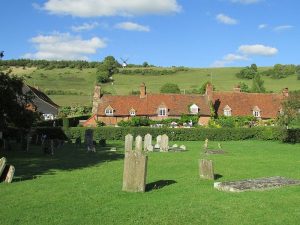
Films offer distinctive and in some respects unique opportunities for representing landscape and, as scholars such as David Lowenthal, David Matless and Paul Readman have amply demonstrated, there is a close connection between landscape representations and narratives of English national identity. It is unsurprising, therefore, that landscape features prominently in many films produced in England during WW2, and in none more so than Went the Day Well (1942). This is premised on the take-over of the sleepy village of Bramley End by an undercover unit of German paratroopers, in advance of a full-scale invasion. There are a number of improbabilities: that the paratroopers should land entirely undetected, that they could speak sufficiently idiomatic English to pass undetected for several hours and that they should succeed in cutting communications so effectively that they are able to hold the village for several days. The reward to viewers for accepting these improbabilities is that they set up a counterfactual examination of how a ‘typical’ English village would react to a German invasion.
Went the Day Well has been praised for its stark realism, including hostage-taking, numerous close-ups of shootings, threats to execute children and the murder of an elderly vicar during a church service. Some critics find this surprising in the context of wartime propaganda. But this is perhaps to misunderstand the film’s purpose, which was surely instructional as much as it was morale boosting. By showing kind-hearted women engaging in acts such as shooting an ex-lover turned traitor in cold blood and distracting a German soldier before smashing his skull with an axe, Went the Day Well sought to prepare peaceable citizens for the ruthlessness and extreme violence they would need to use if they were to resist an invasion effectively. Yet in so doing, it inadvertently exposed a fundamental fault line in English pastoralism, a theme to which I will return below.
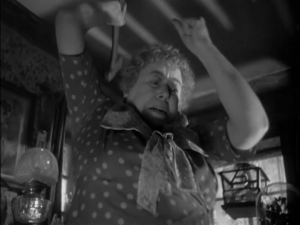
Like a number of other British wartime films, Powell and Pressburger’s A Canterbury Tale for example, Went the Day Well develops a rich vision of what scholars like Alun Howkins and Patrick Wright have referred to as ‘deep England’. As the opening credits roll, we follow the camera down a hedge-fringed country lane to the church which, one of the villagers proudly informs us, dates back to the thirteenth century.

The whole of the rest of the film plays out in and around the village, against a soundtrack of perpetual birdsong. Although Bramley End is fictitious, all the exterior scenes were shot in the quintessentially picturesque Chilterns village of Turville. The windmill, a well-known local landmark, features prominently, as do the brick, tile and half-timbered cottages and the manor house. We look down on the village from above and what we see is the epitome of the idyllic ‘South Country’ version of rural England popularized by poets and artists from the mid-nineteenth century – a small, self-contained settlement, with no modern development, surrounded by lush green pastures, hedges and woods.
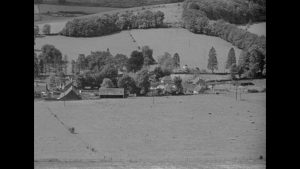
As Howkins showed, South Country landscape representations carry powerful and generally conservative social and political messages. Went the Day Well intends that we should take Bramley End as a microcosm of British society – everyone is here, from the poacher to the lady of the manor. Because a hamlet can plausibly be represented as a gemeinschaft where everyone knows everyone else, society can be portrayed as cohesive and mutually supporting, inhabiting a shared social world. Everyone has their part to play and contributes to the common good: the most privileged character, Lady Fraser, sacrifices herself to save the village children from a hand grenade. This version of history is not necessarily wholly imaginary, but it is profoundly partial, casting a veil over centuries of social, political and religious division in rural communities, let alone British society more widely.
Perhaps the most interesting aspect of Went the Day Well, however, is that it interrogates and comes close to exploding (literally and metaphorically) one of the most fundamental of English landscape narratives: the contrast between a peaceful, harmonious rural homeland and a violent, exploitative foreign ‘other’, out of sight and out of mind. It was Edward Said’s essay ‘Jane Austen and Empire’ that taught us to see how far the first depended on, at the same time as it systematically concealed, the second. Said showed that the domestic order Sir Thomas Bertram establishes at Mansfield Park is the correlate of the imperial order he has previously imposed on his slave plantation in Antigua, and that the civility of the one arises from the unpaid labour of the other. Yet Austen’s novel dwells almost exclusively on the English setting – Antigua is pushed so far into the background that an inattentive reader might easily fail to notice it altogether.
Said’s perspective can be generalized to English rural landscapes in a wider sense. All of them are products of a history of exploitation, some more directly than others of course. The National Trust has recognized that it owns dozens of real-life Mansfield Parks and is seeking to address this through its Colonial Countryside project, while English Heritage also commissioned research on the relationship between slave-owning and some of its properties. Many country houses and landed estates did not draw wealth directly from slave plantations but these cannot be abstracted from the wider historical processes of which they were part either. The trophies, porcelain and furniture in the country houses and the church memorials to generals and admirals fallen in far-flung corners of the empire remind us of that, even if we knew nothing of enclosure or the abject poverty endured by generations of English rural workers who kept the landowners in their pomp.

How far the perceived beauty and peace of the English rural landscape (or, for that matter, of any landscape) must necessarily depend on a similar exclusion from consciousness of linked but incompatible realities, and how far this is historically and geographically contingent, is a question that requires far more careful and extended consideration than is possible in a short blog like this. But Went the Day Well is a fascinating test case of what happens when the barriers that separate the peace of rural England from the displaced violence ‘over there’ are shattered. How far can the values associated with the first withstand direct exposure to the second, or subsequently be reconstituted?
Ostensibly the film returns an optimistic answer. The main action unfolds in flashback, framed by a narrator-villager addressing the viewer from the churchyard, after the defeat of the German invasion. This provides a circular structure that brackets off the disturbing events in between, returning us in the closing sequence to the seamless rural tranquility of the opening. However, the detailed action of the film repeatedly subverts this complacent message. One way in which it does so is by destabilizing the distinction between ‘good’ English and ‘bad’ Germans. We, like the villagers, believe the disguised Germans are English soldiers when we first encounter them (and, in a further twist, they are in fact of course English actors). Conversely, it is only part way through that we discover one of the villagers is a traitor working with the Germans. Just as the Germans commit ruthless acts of violence, so do the villagers. In one scene, a member of the English home guard explains to a disguised German how the village could best be defended from a German attack; later, the Germans use these dispositions to defend themselves from English attack. Since the Germans are wearing English army uniforms, when the attack materializes, it is difficult for the viewer to distinguish between attackers and defenders.
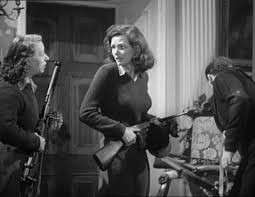 Several of the villagers evidently struggle to maintain the distinction between precious English lives and expendable German lives too. The postmistress looks stricken after she has killed the German billeted on her, to whom she had just been talking in a confiding way. One of the Women’s Land Army girls reacts similarly after shooting a German soldier dead. These responses emanate from the compassionate humanism the film celebrates as intrinsic to ‘deep England’, but they are quickly swept aside: the postmistress is killed within moments and the Land Girl told by her companion that they should compete to see how many Germans they can kill.
Several of the villagers evidently struggle to maintain the distinction between precious English lives and expendable German lives too. The postmistress looks stricken after she has killed the German billeted on her, to whom she had just been talking in a confiding way. One of the Women’s Land Army girls reacts similarly after shooting a German soldier dead. These responses emanate from the compassionate humanism the film celebrates as intrinsic to ‘deep England’, but they are quickly swept aside: the postmistress is killed within moments and the Land Girl told by her companion that they should compete to see how many Germans they can kill.
Another way the details of Went the Day Well undermine English pastoral is in the representation of war memorials, of which there are two in the film (and a third conspicuous by its absence). The significance of the WW1 memorial plaque on the outside wall of the church appears simple enough: it underlines the theme of self-sacrifice. For the rest of us, and future generations, to continue to enjoy the peace, beauty and contentment that Bramley End is meant to encapsulate, it is necessary that those called upon to defend England from her enemies should be prepared to give their lives. Rural war memorials are a prime example of the process of spatial dissociation identified by Said. Quietly set in a churchyard or on a village green, they serve to recuperate the violence of war and absorb it into pastoral peace. Like slave ownership in Mansfield Park, the violence signified by war memorials takes place elsewhere, in some distant land across the sea; only a faint echo reaches us from there. In the film, however, the promise implied by the WW1 memorial has proved hollow, since violence has terrifyingly broken through into the sanctuary of peace (a message underscored by the first killing in the film, of the vicar while officiating in his own church).
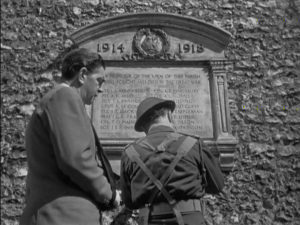
The WW1 memorial invites comparison with the WW2 memorial that features prominently in the introductory and closing frame to the film. This is in the archetypical form of a churchyard cross – but startlingly it turns out to be a memorial to the Germans killed during the battle (and so another example of the blurring of identities). Their deaths cannot be redeemed according to the same logic of self-sacrifice: they died, so the film has it, to destroy rather than maintain the British way of life. The recuperative pastoral of the village war memorial at best remains incomplete, perhaps even breaks down altogether. This is emphasized by the obtrusively raised mound under which the Germans lie buried, disrupting the level harmony of the churchyard. ‘That’s the only bit of England that they got’, the narrator informs us proudly. Yet much of the consolation village war memorials offer derives from the tranquility of their setting. To insist on such an emphatic demarcation between the two – the wider pastoral landscape unavailable to the dead Germans – is also to admit that some wrongs and suffering are beyond the power of pastoral to encompass, thus narrowing and qualifying its redemptive claims.
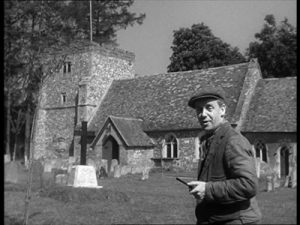
As the film closes, the narrator tells us that what he and those he speaks for are most proud of is the villagers who died to defend Bramley End, but no physical memorial to them is shown, no doubt because it would chime awkwardly with the churchyard cross commemorating the Germans. The promise that the sacrifice of those who died in war will never be forgotten is always, at least with respect to the individual, an exercise in wishful thinking, since all of us eventually are forgotten; here the promise seems even less adequate to the sacrifice than usual – words spoken into thin air.
In these and other ways, Went the Day Well is a surprisingly, if perhaps unwittingly, subversive film, exposing the foundations and calling into question the universality of some of the most influential narratives of English pastoralism.

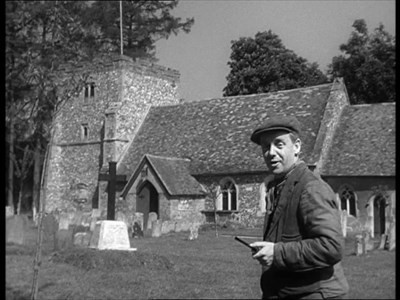
I just saw this film at MoMa in New York. This is a very thoughtful appraisal. I did not notice that the memorial at the end was for the Germans rather than the English villagers who died defending their town and country.
Excellent article, beautifully and thoughtfully expressed. I’d like to know who the writer is in relation to the university.
The thing that strikes me every time I watch Went the Day Well is that, in the first scene, the narrator talks about the eventual victory over Hitler, even though the film was made, and set, in 1942. Such confidence!